The rings close up almost completely this season. Because of the relative orientations of the Earth's orbit and the plane of Saturn's rings, as seen from here, the rings will appear to close almost completely by late December before opening again until April of next year. Resolving the rings at all in December 2008 will be difficult (I wonder if I will be able to see them). In September 2009, we will pass through the plane of the rings and they will be invisible in all but the largest instruments. (Saturn will be on the other side of the Sun at the time.) Thereafter the rings will open again and we will see their northern side.
Passing close to the plane of the rings means that transits of the satellites will occur. However resolving them will be much more difficult than for the major satellites of Jupiter.
The images are in chronological order, so the best may well be in the middle.
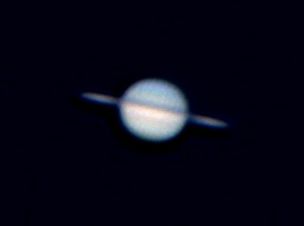 |
My first picture of the season. Saturn was low in the early-morning sky (25° and right over the nearby town) when this picture was taken only an hour before sunrise. Saturn was 1,507 million kilometres (10.07 AU) away and subtended an angle of 16 arc-seconds. Mimas was in transit at this time, but there is no way I could resolve it.
Date and Time: 22nd October 2008 05:41 UT
Camera: ToUcam 740K
Telescope: LX200 with X2 lens and Neodymium filter
Capture: K3CCDTools. Low gamma, high saturation, 1/25", 63% gain, 1210 frames
Processing: Registax. 647 frames stacked, histogram 0-160, wavelets 1-3 = 10.
FocusMagic 5,50.
|
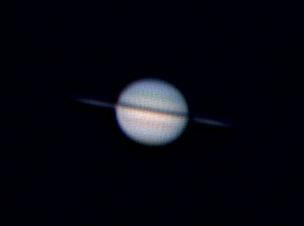 |
My second picture of the season. Saturn was better-placed in the early-morning sky (40°) when this picture was taken 2 hours before sunrise. Saturn was 1,418 million kilometres (9.48 AU) away and subtended an angle of 17 arc-seconds. No satellites were in transit at the time. The rings are closing, but still visible as a narrow line.
Date and Time: 3rd December 2008 05:27 UT
Camera: ToUcam 740K
Telescope: LX200 with X2 lens and Neodymium filter
Capture: K3CCDTools. Low gamma, high saturation, 1/25", 60% gain, 358 frames
Processing: Registax. 165 frames stacked, wavelets 1-2 = 10, histogram 0-225. |
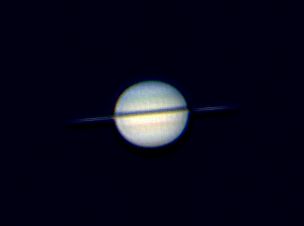 |
My third picture of the season. Although Saturn was slightly higher in the sky (42°) for compared with the last one, conditions were not so good, with some high cloud, so I had to use a higher gain on the camera which has resulted in the slightly blue background to the picture. Saturn was 1,352 million kilometres (9.04 AU) away and subtended an angle of 18 arc-seconds. I think the rings were past their narrowest by this date and were just beginning to open again, but there would not be a great difference. Clearly I can see them.
Date and Time: 30th December 2008 04:38 UT
Camera: ToUcam 740K
Telescope: LX200 with X2 lens
Capture: K3CCDTools. Low gamma, high saturation, 1/25", 60% gain, 643 frames
Processing: Registax. 308 frames stacked, histogram 0-160, wavelets 1-2 = 5.
Focus Magic 5,100 |
Although conditions on 30 December were far from ideal, I was able to capture a few of the satellites, even at ×2. The first picture below was taken at 04:32 using a high gamma on the camera to increase the contrast for faint objects (but producing the blue background). Titan clearly shows, but Rhea is a little more difficult to see. Tethys was where I've indicated it, but can you really distinguish it from the noise?
The second picture below was taken at prime focus and is a composite of two pictures, one exposed for the satellites and one for the planet. However the mouseover shows the satellite image without superimposing the better picture of the planet. You can see how clearly the rings show up on the grossly over-exposed image. |
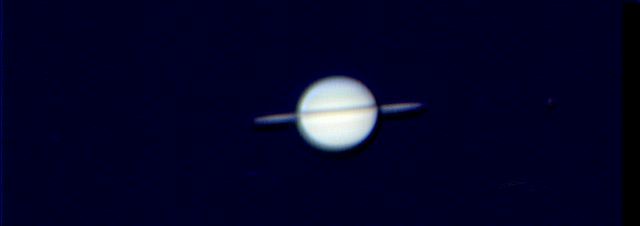 Date and Time: 30th December 2008 04:32 UT
Date and Time: 30th December 2008 04:32 UT
Camera: ToUcam 740K
Telescope: LX200 with X2 lens
Capture: K3CCDTools. High gamma, high saturation, 1/25", 40% gain, 788 frames
Processing: Registax. 625 frames stacked, histogram 0-165, wavelets 1-2 = 10.
|
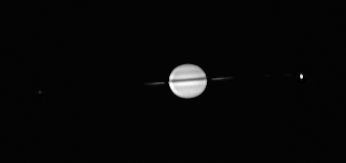 Date and Time: 30th December 2008 04:08 and 04:16 UT
Date and Time: 30th December 2008 04:08 and 04:16 UT
Camera: ToUcam 740K
Telescope: LX200 at prime focus
Capture: K3CCDTools. Planet: Low gamma, 1/25", 20% gain, 612 frames
Satellites: High gamma, 1/25", 36% gain, 684 frames
Processing: Registax. Planet: 524 frames stacked, gamma 1.6, wavelets 1-2 = 5.
Satellites: 472 frames stacked, gamma 1.6
Final images converted to monochrome.
|
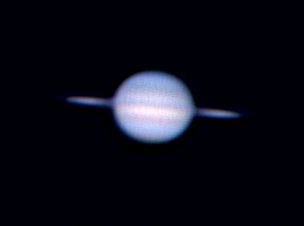 |
My fourth picture of the season. There has been a long interval since my last image caused by the bad weather we have had this season. Saturn was better-placed in the evening sky and this picture was taken 1½ hours before culmination but was nevertheless at an altitude of 40°. Saturn was 1,258 million kilometres (8.41 AU) away and subtended an angle of 19 arc-seconds. No satellites were in transit at the time. The rings were beginning to open again, and I think that is visible despite the rather poor image.
Date and Time: 1st March 2009 23:15 UT
Camera: ToUcam 740K
Telescope: LX200 with X2 lens and IR-block filter
Capture: K3CCDTools. Low gamma, high saturation, 1/25", 55% gain, 912 frames
Processing: Registax. 266 frames stacked, wavelets 1-3 = 10, histogram 0-160,
gamma 0.9. |
The night of the 18th March 2009 was clear, so I decided to do something I had been meaning to do for some time, which was to take pictures of the same object (Saturn in this case) with both my 254-mm (10-inch) LX200 and my 125-mm (~5-inch) ETX125. I have long suspected that in the conditions I usually have, the extra size of the LX200 yields little or nothing to the quality of the images I get. The upper of the two images below was taken with the ETX125 and the lower one with the LX200. The pictures were taken about 1 hour 20 minutes apart due to problems I had remembering how to handle the ETX and to get it focused, and I cannot be certain that seeing conditions had not changed between the two imaging sessions. In each case I took a number of AVIs and selected the best pictures after processing them. No importance should be attached to the different colour of Saturn between the two pictures. They were taken with my trusted old Philips 740K which seems to have developped a hot, blue pixel. This is towards the upper left of the frame and I have cropped the pictures so that it does not appear in them, but it did mean that I could not balance the colours as I normally would using the brightness meter in K3CCDTools because it always registered the single hot pixel in the blue channel, so I had to judge it manually - not an easy task. The difference in size is real and caused by the fact that the ETX has a shorter focal length (1900 mm) compared with the LX200 (2450 mm). I leave you to judge which is the better image.
Saturn was 1,258 million kilometres (8.41 AU) away and subtended an angle of 19 arc-seconds and was at an altitude of 43° and 44° Culmination that night was at 23:38.
|
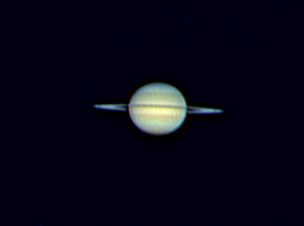 |
Date and Time: 19th March 2009 00:43 UT
Camera: ToUcam 740K
Telescope: ETX125 with X2 lens and Neodymium filter
Capture: K3CCDTools. Low gamma, high saturation, 1/25", 63% gain, 1241 frames
Processing: Registax. 574 frames stacked, wavelets 1-2 = 10, histogram 0-180, gamma 0.9. |
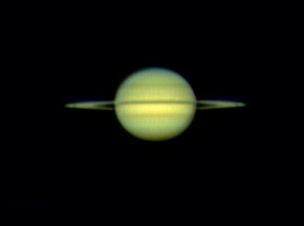 |
Date and Time: 18th March 2009 23:17 UT
Camera: ToUcam 740K
Telescope: LX200 with X2 lens and Neodymium filter
Capture: K3CCDTools. Low gamma, high saturation, 1/25", 42% gain, 1003 frames
Processing: Registax. 798 frames stacked, wavelets 1-2 = 10, histogram 0-200, gamma 0.9. |
Also on that night (18th March) I took what, to me, is a most remarkable picture. Never before have I managed to get a picture showing details on Saturn and capturing its satellites in a single exposure. I have no idea how I did it, but here it is. There are in fact five satellites in the picture but you may only be able to see three or four in this picture. However if you move your mouse over the image you will see a version with the gamma increased to 3.0, which enhances the contrast in the dark areas, with the satellites named. Enceladus is the faintest (magnitude 11.6) and may still be difficult to see so an arrow points to it.
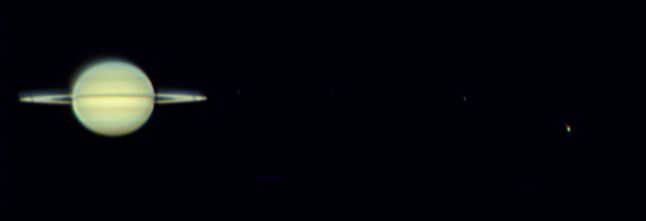
Date and Time: 18th March 2009 23:22 UT
Camera: ToUcam 740K
Telescope: LX200 with X2 lens and Neodymium filter
Capture: K3CCDTools. High gamma, high saturation, 1/25", 55% gain, 1056 frames
Processing: Registax. 743 frames stacked, wavelets 1-2 = 10, histogram 0-180, gamma 0.6. Blue colour reduced. |
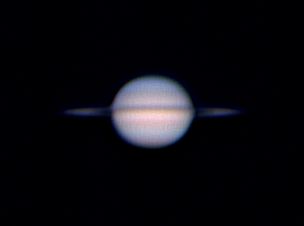 |
Two weeks later, little had changed except the seeing. Saturn was past opposition so was beginning to recede. It was 1,270 million kilometres (8.49 AU) away and subtended an angle of 19 arc-seconds. The picture was taken with my Toucam 840K which doesn't have the hot, blue pixel.
Date and Time: 1st April 2009 20:33 UT
Camera: ToUcam 840K
Telescope: LX200 with X2 lens and Neodymium filter
Capture: K3CCDTools. Low gamma, high saturation, 1/25", 55% gain, 448 frames
Processing: Registax. 374 frames stacked, wavelets 1-2 = 10, histogram 0-150. |
|
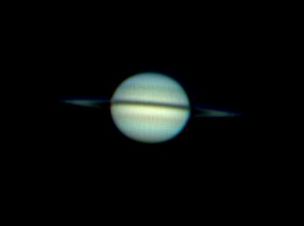 |
Another two weeks later, again little had changed. Saturn was 1,296 million kilometres (8.66 AU) away and subtended an angle of 19 arc-seconds.
Date and Time: 19th April 2009 20:22 UT
Camera: ToUcam 840K
Telescope: LX200 with X2 lens
Capture: K3CCDTools. Low gamma, high saturation, 1/25", 40% gain, 1064 frames
Processing: Registax. 500 frames stacked, wavelets 1-2 = 10, histogram 0-135. |
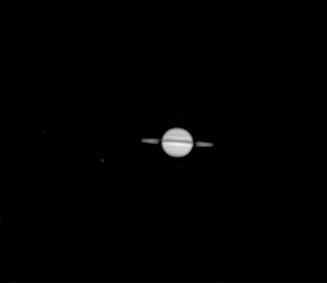 |
A few days later I tried imaging Saturn with my MX716 camera. The image is much smaller because the chip is bigger than the one in the Toucam. The camera resolved some detail on the planet and picked up two satellites (Rhea and Titan). The mouseover shows a 1-second exposure which picked up Iapetus too. You can see that Iapetus does not revolve in the plane of the rings. There is a very small dot near the end of the arrow which is about where Dione was at the time, but it may be wishful seeing to believe it is there. Saturn was 1,299 million kilometres (8.68 AU) away and subtended an angle of 19 arc-seconds.
Date and Time: 21st April 2009 20:46 UT
Camera: MX716
Telescope: LX200 with X2 lens
Capture: star_mx7. Exposure 20 msec, 52 frames
Processing: Registax. 52 frames stacked, wavelets 1-2 = 10, gamma 2.0, histogram 45-210. |
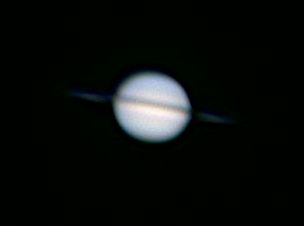 |
41 days later. By this time Saturn was getting very low in my sky by the time it gets dark at this time of the year. However you may be able to see that the rings are beginning to close again. By the time Saturn reappears in our morning skies, we will have passed through the ring plane and we will see the rings from the north. As Saturn recedes now, this may probably be the last picture for this season. Saturn was 1,390 million kilometres (9.30 AU) away and subtended an angle of 17 arc-seconds.
Date and Time: 1st June 2009 22:31 UT
Camera: ToUcam 840K
Telescope: LX200 with X2 lens
Capture: K3CCDTools. Low gamma, high saturation, 1/25", 50% gain, 1006 frames
Processing: Registax. 200 frames stacked, gamma 1.3, histogram 0-220, wavelets 1-2 = 10. |

